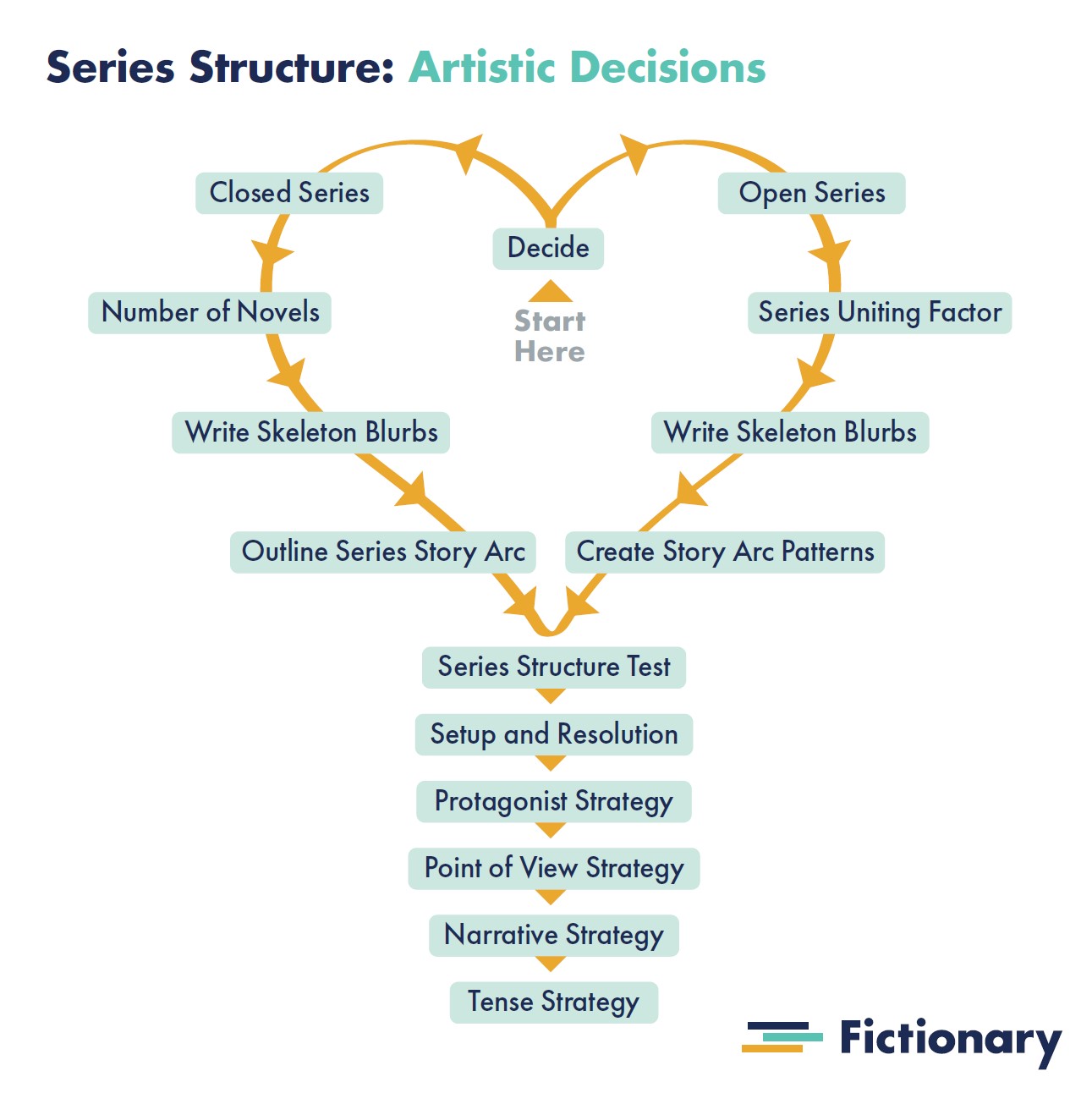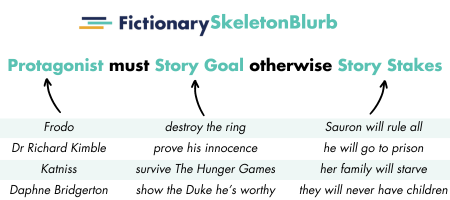Structuring an entire series of books can feel daunting. Find out how to do it right with help from Fictionary.

Writing a series is a right of passage for many romance, fantasy, and crime writers.
When they are done well, they can become fan favorites, loved by readers for generations. But when there are inconsistencies, gaps, insufficient stakes, they can fall flat before readers even reach book two.
That’s why it’s so important to spend time thinking about how your individual story arcs fit within your overall series arc. It’s not easy—in fact, I teach a whole 6-week course that helps authors make sure that they have the right foundations in place for their series. But hopefully this article will help you get some of the essentials in place for an unforgettable series. And if you still have questions, join my free webinar: Beyond Book 1: How to Structure Your Entire Book Series
Ok, let’s get started. Here are the ten things to consider when writing a series:
1. Series Type
There are two types of series: closed and open.

A closed series is united by plot, contains a fixed number of novels, must be read in order, and addresses the series goal in the final novel. Think The Hunger Games, Bridgerton, or Harry Potter.
An open series is united by setting and/or characters, contains an unlimited number of novels, can be read in any order, and addresses the story goal at the end of each novel.
It’s essential that you decide if you are writing an open or closed series before you put pen to paper.
2. Number of Novels
The second decision you need to make as a writer is how many novels you will write, or, if you’re writing an open series, what the uniting factor should be.
For example, the uniting factor in the Hercule Poirot 34 book open series, the uniting factor is the discerning detective Poirot.
Remember that a closed series doesn’t mean it needs to be a trilogy. It could be a duology, like Strange The Dreamer, a tetraology (four) like The Thursday Murder Club,or much longer, like the epic fourteen book Wheel of Time series.
3. Write Your Skeleton Blurb
Now it is time to write your series skeleton blurb, which is the shortest version of a blurb that answers three questions:
- Who is the protagonist?
- What is their goal?
- What is at stake?

A skeleton blurb helps you stay focussed when writing and editing and lets you easily determine if a scene does or doesn’t belong in your novel.
4. Create Your Story Arcs
The story arc has different roles for a single novel and for a series. The five story arc scenes—inciting incident, plot point 1, middle plot point, plot point 2, and climax—are the minimum scenes necessary to create a structurally sound story.
A closed series will have a series-level story arc that starts in book one and ends in the final volume. There will also be a story arc for each book in the series.
In an open series, there is no overarching story arc across the series, but, there are patterns to the story arc scenes across the series. The open series story arc scenes must resonate through the series; otherwise, the series will not hold together.
5. The Series Structure Test
Step five is a quick quality check. In just an hour, catch any gaps or inconsistencies before you start writing and save weeks or even months in writing and editing.
The structure test differs depending on whether you are writing a closed or open series. For a closed series, you need to answer these questions:
- Does the climax scene in the final novel address the series story goal?
- Are the stakes higher in each consecutive novel?
- Does each novel have a different climax scene?
- Does the climax scene of the series mirror one of the story arc scenes in one of the previous novels?
For an open series, you need to answer these questions:
- Is there a setting or a character that unites all the novels?
- Is each novel a stand-alone story?
- Does each novel address the open series story goal in an “answered for now” way?
- Does each novel have different story arc scenes?
If any of your answers were blank or a little hazy, it is well worth going back through the previous steps and tightening your skeleton blurb and story arc.
Now that you've developed your series framework and aced the Structure Test, you can move on to 5 key decisions and strategies that you need to think through.
6. Setup and Resolution Strategy
The setup is everything that comes before the inciting incident. The resolution is everything that comes after the climax.
Each novel in a closed series must have an ordinary world that is different from the ordinary world in the previous novels.
Each novel in an open series must show the ordinary world, but in book two and onward the author must show that world quickly because the reader is already familiar with it.
7. Protagonist Strategy
At the heart of every story lies the protagonist, the character who takes center stage in the pursuit of a specific goal. This goal, often outlined in the skeleton blurb, is the driving force of the narrative. The protagonist has the most riding on the outcome, standing to gain or lose the most depending on their success. While personal growth isn't always guaranteed, the protagonist's journey is central to the story's development.
A protagonist strategy means you’re deciding whether you’re writing with a single, combined, or group protagonist. Think The Hunger Games by Suzanne Collins, Allegiant, the third book in the Divergent series by Veronica Roth, and Game of Thrones by George R. R. Martin.
8. Point of View Strategy
Writing from a character’s POV means the story or scene is filtered through one character’s perspective. The story or scene unfolds entirely through their lens, transporting the reader into their world. Through the character's POV, we experience sights, sounds, emotions, and even physical sensations firsthand, creating a deeper connection to the story.
You have two choices:
- There is one POV character, meaning every scene will be written from one character’s perspective.
- There are more than one POV characters, meaning for each scene you must choose whose perspective the scene will be written from.
9. Narrative Strategy
There are three main narrative choices. These are the first person, the second person, and the third person.
- First Person: “Don’t tell me what to do,” I said.
- Second Person: “Don’t tell me what to do,” you said.
- Third Person: “Don’t tell me what to do,” she said.
10. Tense Strategy
This is your final decision before you start writing your series. Remember, there's no right or wrong answer. The most important thing is to pick one and keep the story rolling. Don't get bogged down here!
If your initial choice doesn't feel right later, you can always adjust as you write. However, making a conscious decision now will keep this element in the back of your mind as you craft your scenes.
For now, all you need to do is decide if you’re writing your series in past or present tense.
Kristina Stanley is an award-winning author and fiction editor. She is the founder and CEO of Fictionary. Fictionary is for creative writers who want to hone their writing skills, connect with writers and editors, and self-edit more effectively. Her novels include The Stone Mountain mystery series. Her first novel Descent was nominated for the 2014 Arthur Ellis Unhanged Arthur for excellence in crime writing. Blaze was shortlisted for the 2014 Crime Writers’ Association Debut Dagger. Her most recent publications are Secrets to Writing a Series, Secrets to Outlining a Novel, and Secrets to Editing Success. You can find out more at Fictionary.co.
Comments